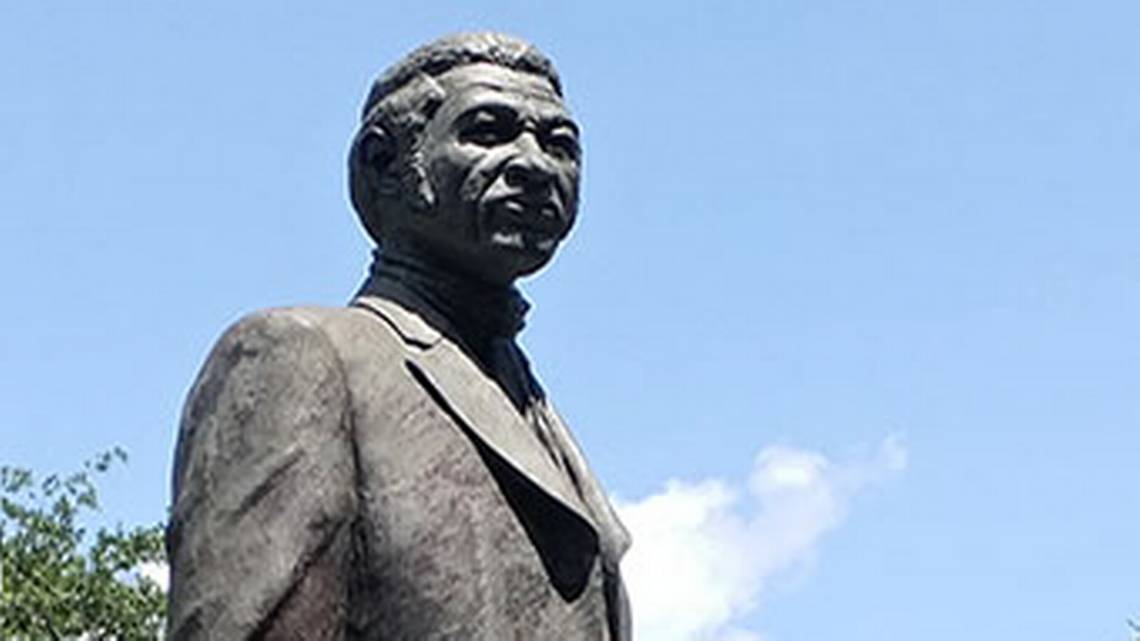Armed Struggle in South Carolina: The Life of Denmark Vesey
Posted by Pete on Jul 2nd 2024

Executed on this day in 1822, Denmark Vesey organised a mass slave rebellion in South Carolina
In the 1820s, a spectre was haunting white supremacy – the spectre of the Haitian Revolution.
Slaveowners in the U.S. South were terrified that the victorious struggle for black liberation in nearby Haiti might be repeated by enslaved black labourers in mainland North America.
These exploiters knew there was the potential for such a revolution built into the slave system they lived off.
Human beings have never accepted such degradation and abuse without resistance. Southern slaveowners were right to be afraid.
The French Revolution of 1789 promised freedom and equality for all - and two years later, the slave rebels in French Haiti took their freedom by force
See the Storming of the Bastille tea towel
As the Trinidadian historian C. L. R. James wrote of the Haitian struggle:
When history is written as it ought to be written, it is the moderation and long patience of the masses at which men will wonder, not their ferocity. The cruelties of property and privilege are always more ferocious than the revenges of poverty and oppression.
In early-nineteenth-century South Carolina, the popular hopes and elite fears about black liberation came to a head around the figure of Denmark Vesey.
Vesey was born ‘Telemaque’ in the Danish colony of St. Thomas.
He was enslaved by a sea captain, Joseph Vesey, and used as an assistant.
This experience meant that Telemaque became very familiar with the wider Caribbean world in the age of the Haitian Revolution.
Telemaque also learned multiple languages – French, Spanish, English – which would help with organising linguistically diverse groups of enslaved workers in the future.
After the end of the Revolutionary War in North America, Joseph Vesey retired to Charleston.
Then, on 9 November 1799, Telemaque won $1,500 in a city lottery, and he used $600 of this to purchase his legal freedom.
Like Denmark Vesey, John Brown was tried and executed by pro-slavery southerners for his role in organising a slave rebellion
Emancipated, Telemaque now took the name ‘Denmark Vesey’ and began work as an independent carpenter.
But Vesey wasn’t willing or able to leave the question of black slavery behind him.
His first wife, Beck, was still enslaved. As a result, Denmark and Beck’s children were enslaved, too. And the people who were enslaving them refused to allow Denmark to buy his family’s freedom.
Denmark also continued to spend much of his social life with enslaved black men and women in Charleston, especially in Church.
In 1818, Vesey helped to co-found a congregation of the African Methodist Episcopal (AME) Church in Charleston.
The new religious space was meant to give enslaved African and African-American spiritual support without the stifling, racist restrictions put on black members by the white-led Presbyterian Church.
Soon, Vesey’s Charleston branch of the AME was the largest in the U.S., with over 1,800 members.
The Church was also a useful setting in which to organise resistance to slavery.
The Thirteenth Amendment which abolished slavery was passed in January 1865, 43 years after Denmark Vesey was executed
See the Reconstruction Amendment tea towel
Christian theology provided some powerful passages for use in anti-slavery agitation, and the social space for black political organising in the AME was precious.
Although much of the historical evidence has been corrupted or skewed by vengeful white planters, it seems that, in 1822, Denmark Vesey planned to arm thousands of black slaves in South Carolina, rise up against the slaveowners, and escape to freedom in Haiti.
The date chosen for the uprising was 14 July - Bastille Day.
But a couple of defectors leaked the plan to the white ruling class in May – a white ruling class primed by the social revolution in Haiti to fear any hint of slave rebellion.
The white elite of Charleston quickly mobilised a racist white militia and set to hunting down the black conspirators.
Hundreds were arrested and imprisoned in the city workhouse, and the white planters also exploited the moment to destroy the AME Church in Charleston.
A farcical ‘court’ was created to prosecute Vesey, which accepted evidence against men who had not yet even been charged, and testimony which had been extracted by violence and the threat of violence.
Vesey and five enslaved black men were quickly sentenced to death and executed by hanging on 2 July 1822.
In the weeks that followed, 131 more black men were arrested in and around Charleston. 35 of them would be hanged and 31 deported from the U.S.
Denmark Vesey’s attempt at rebellion had failed, and the white terror which followed was a major blow for black political activity in South Carolina.
But it was only a temporary victory for the planters.
The rest of the nineteenth century was full of acts and campaigns of anti-slavery rebellion in the U.S., culminating in the massive slave uprisings which helped the Union win the Civil War.
In fact, Denmark and Beck Vesey’s sons, Randolph and Robert, lived to see and benefit from the Emancipation Proclamation, and Robert took part in the Union victory celebrations in 1865.
Denmark Vesey may have been defeated in 1822, but his family, his people, and his political cause prevailed in the end.



